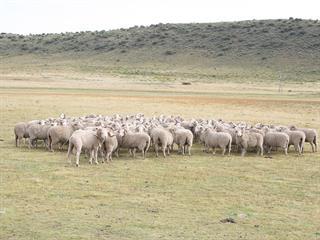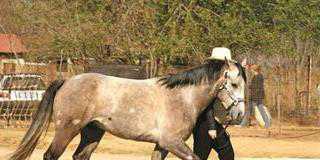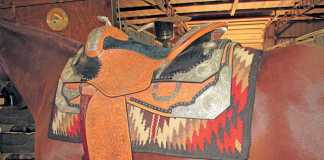
Merino sheep farmer Jan van Pletzen started farming on leased land in 1976. From the beginning, he was determined to ensure excellence, and used rams from the Zeiss Jordaan Stud. These formed the genetic basis of his stud which he started in 1982 by registering 50 of his best flock ewes.
After registering the stud, Jan purchased rams from Andries (Tot) Pienaar and Andries (Klein Andries) Pienaar from Hanover and Stefan Naudé of the Geelbek Elite Group. In 1987, Jan bought and relocated to the farm Sterkfontein near Jamestown in the Eastern Cape. Today, he runs his Sterkfontein Stud in partnership with his two sons Ras and Niel. Jan has a 50% share and Ras and Niel hold 25% each. Ras started farming in 1995 on the farm Modderpoort and relocated to the farm Hester in 2008. Both farms are in the Jamestown district.
On Sterkfontein, 40% of the lands are under oats and the balance are under wheat and rye. The sheep component consists of 350 stud ewes, 2 000 flock ewes and 200 rams. Between 500 and 600 calves from a Beefmaster stud herd top the tall growing grasses.
Of the approximately 80ha dryland lucerne, 20ha are grazed by stud ewes and 60ha by commercial flock ewes. The average carrying capacity of the farm is 1ha/SSU or 6ha/MSU. Rather than increasing the size of the flock, the Van Pletzens concentrate on improving the depth and quality of their sheep run under harsh, extensive conditions.
Terrain
Sterkfontein totals 1 280ha, with the homestead situated at an altitude of 1 700m and the highest peaks reaching 1 800m.
The vegetation is mixed grassland. The mountainous veld on the south-facing slopes consists mainly of unpalatable grasses such as wire grass (Elionurus muticus), mountain wire grass (Merxmuellera disticha) and odd patches of turpentine grass (Cymbopogon spp.).
The northern slopes have more palatable grasses such as red grass (Themeda triandra), Setaria species such as small creeping foxtail (S. flabellata) and Digitaria species such as finger grass (D. eriantha). The mountains also have a fair amount of resin bush (Euryops spp.) and odd patches of renoster bush (Elytropappus). Problem plants such as bankrupt bush (Stoebe vulgaris) occur mostly lower down on the lower mountain slopes.
Sterkfontein has no irrigation and all the arable lands are farmed under dryland conditions. Most are relatively shallow Clovelly soils, and the poorer soils are more of a Sterkspruit type.
Breeding and selection
The stud ewes are shorn before lambing in May, the flock ewes in September and the wethers in October. At these times, the wool usually has 12 months of growth. With wool quality and length as primary factors, the breeding goal is to obtain maximum meat and wool production per sheep. This also means achieving maximum production of meat and wool per hectare. The aim is for every ewe to produce a minimum of 5kg greasy wool with a minimum of 76% clean fleece yield and an average clean fleece weight of 3,8kg to 4kg. All ewes shearing below 5kg greasy wool are culled.
Breeding methods
The Sterkfontein Stud started using Best Linear Unbiased Prediction (BLUP) breeding values in 1996 and was one of the first studs in the area to do so. BLUP has had a major impact on the stud, increasing conception rate, lamb growth and clean wool production.
Rams are put to the ewes in single-sire breeding flocks of one ram to 50 ewes, allowing foolproof paternity confirmation – from roughly 10 March to 9 April. Such a high ewe-to-ram ratio reduces the number of sires, colour-tagged for easy identification, in the stud. However, this method does entail greater risk should anything happen to one of the rams.
If a specific proven sire is not available for natural mating, the Van Pletzens use laparoscopic AI to introduce new genetic material into the stud. Only 25% of the stud ewes are thus inseminated; the balance have natural service. There is no corrective mating, specific genetic lines are occasionally combined to achieve a specific objective. Selection for fertility is very strict: any ewe failing to become pregnant within 30 days is culled. If it is a young stud ewe, it is downgraded to a flock ewe.

From left: Niel, Jan and Ras van Pletzen. Jan started a Merino stud flock in 1982.
Conception rate
The stud regularly achieves a conception rate of 98%. The ewes are put in a camp near the homestead for lambing. Lambing pens are used only for ewes with twins; they are kept in the pens for two to three days before being moved onto a green feed pasture. An overall lambing rate of 150% and a weaning rate of 135% are not unusual.
Feed and dosing
The sheep receive a production lick ad lib, mixed with Voerdokter diatomaceous earth. Two weeks before lambing, pregnant ewes each receive 300g lamb and ewe cubes mixed with 200g maize daily. Ewes and their lambs are run on green feed until the lambs are ready for weaning. After weaning, the lambs are put onto dryland lucerne until they are 12 months old.
Sheep do not receive bought-in feed or cubes. Ewes are dosed in a blanket dosing programme a week or two before being mated, and again soon before lambing. All other sheep are dosed at the same time. The sheep are dipped against the Karoo paralysis tick just before the winter or the first frost. Only if there is a severe infestation of ticks are they again dipped later, towards summer. The Van Pletzens lose very few sheep from diseases such as pulpy kidney, thanks to a regular vaccination programme.
Stock losses
Jackal and caracal kill about 3% of the sheep annually. Stock theft has become a serious problem of late, with Niel losing
120 wethers in one night. On average, stock theft leads to a loss of 10% to 15% of the total sheep flock a year.
Seeing results
The Van Pletzens combine their annual production sale with those of two other Van Pletzen family Merino studs. A total of between 80 and 100 rams, of which 10% to 15% have Silver Merit status, are usually on offer. The studs have won many championships at Eastern Cape shows and are well-known for the high quality of their wool sheep.
Phone Ras van Pletzen 082 301 9061 or email [email protected].













